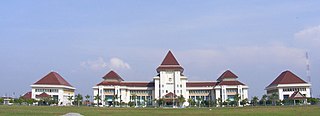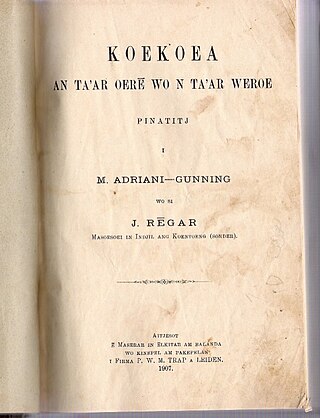Related Research Articles
Krio Dayak is a Kayan language of the Krio Dayak people in West Kalimantan, Indonesia.

The Language Development and Fostering Agency, formerly the Language and Book Development Agency and the Language Centre, is the institution responsible for standardising and regulating the Indonesian language as well as maintaining the indigenous languages of Indonesia. It is an agency under the Ministry of Education, Culture, Research and Technology of Indonesia.
The Simeulue language is spoken by the Simeulue people of Simeulue off the western coast of Sumatra, Indonesia.
The Minahasan languages are a subgroup of the Austronesian languages spoken by the Minahasa people in northern Sulawesi, Indonesia. They belong to the Philippine subgroup.

Cikarang is a town serving the seat of Bekasi Regency, West Java, Indonesia. The biggest industrial estate in Southeast Asia, Kota Jababeka is located there.
Lawangan is an Austronesian language of the East Barito group. It is spoken by about 100,000 Lawangan people living in the central Kalimantan, Indonesia. Lawangan has a high degree of dialectal diversity.
Palembang, also known as Palembang Malay, or Musi, is a Malayic language primarily spoken in about two thirds of South Sumatra Province in Indonesia, especially along the Musi River. It consists of two separate but mutually intelligible dialect chains: Musi and Palembang. The urban Palembang dialect is a koiné that emerged in Palembang, the capital city of South Sumatra. It has become a lingua franca throughout major population centers in the province, and is often used polyglossically with Indonesian and other regional languages and dialects in the area. Since parts of South Sumatra used to be under direct Malay and Javanese rule for quite a long time, the speech varieties of Palembang and its surrounding area are significantly influenced by Malay and Javanese, down to their core vocabularies.

Minahasa Regency is a regency in North Sulawesi, Indonesia. Its capital is Tondano. It covers an area of 1,141.64 km2 and had a population of 310,384 at the 2010 Census; this rose to 347,290 at the 2020 Census, and the official estimate as at mid 2022 was 350,317.
The Biatah language is spoken in the Malaysian state of Sarawak and the Indonesian province of West Kalimantan. It belongs to the Malayo-Polynesian branch of the Austronesian language family.
Yaqay is a Papuan language spoken in Indonesia by over 10,000 people. It is also called Mapi or Sohur; dialects are Oba-Miwamon, Nambiomon-Mabur, Bapai.
Banda is an Austronesian language of the Central Maluku subgroup. Along with Kei, it is one of the two languages of the Kei Islands in the Indonesian province of Maluku.
Waropen is an Austronesian language spoken at the Geelvink Bay of Indonesian Papua. It is fairly closely related to the Yapen languages. Dialects are Waropen Kai, Napan, and Ambumi.

Tontemboan is an Austronesian language, of northern Sulawesi, Indonesia. It is a Minahasan language, a sub-group of the Philippine languages.
Kendayan, or Salako (Selako), is a Malayic Dayak language of Borneo. The exact number of speakers remains unknown, but is estimated to be around 350,000.
Talaud is an Austronesian language spoken on the Talaud Islands north of Sulawesi, Indonesia.
Basap is an Austronesian language spoken in Borneo, Indonesia.
Tolaki (To'olaki) is the major language of Southeast Sulawesi, Indonesia. It is an Austronesian language of the Celebic branch.
Pakpak, or Batak Dairi, is an Austronesian language of Sumatra. It is spoken in Dairi Regency, Pakpak Bharat Regency, Parlilitan district of Humbang Hasundutan Regency, Manduamas district of Central Tapanuli Regency, and Subulussalam and Aceh Singkil Regency.
Dusun Deyah, or Deyah, is a language spoken by a group of Dusun people of South Kalimantan province, Indonesia. It is spoken in Tabalong Regency across two districts: Haruai, in the villages of Kinarum, Kaong, Pangelak, and Bilas, and Muara Uya, especially in the village of Mangkopom.

Bungku people are an ethnic group who mostly resides in North Bungku, South Bungku, Central Bungku, and Menui Islands districts di Morowali Regency, in Central Sulawesi province of Indonesia. This ethnic group is divided into several sub-groups, namely Lambatu, Epe, Ro'tua, Reta, and Wowoni. Bungku people have their own language, called Bungku language, which is one of their characteristic and serves as a means of communication between themselves. They generally embrace Islam or Christianity.
References
- ↑ Tombulu at Ethnologue (18th ed., 2015) (subscription required)
- ↑ Sahulata, D. (1993). Struktur bahasa Tombulu. Jakarta: Pusat Pembinaan dan Pengembangan Bahasa, Departemen Pendidikan dan Kebudayaan.
- ↑ Makalew-Palar, J.A.; Kembuan, L.D.; Terak, R. (1994). Fonologi Bahasa Tombulu. Jakarta: Pusat Pembinaan dan Pengembangan Bahasa, Departemen Pendidikan dan Kebudayaan.
- ↑ "Penyusunan Alkitab Bahasa Tombulu Butuh 17 Tahun". ManadoPostonline.com (in Indonesian). 30 November 2018.